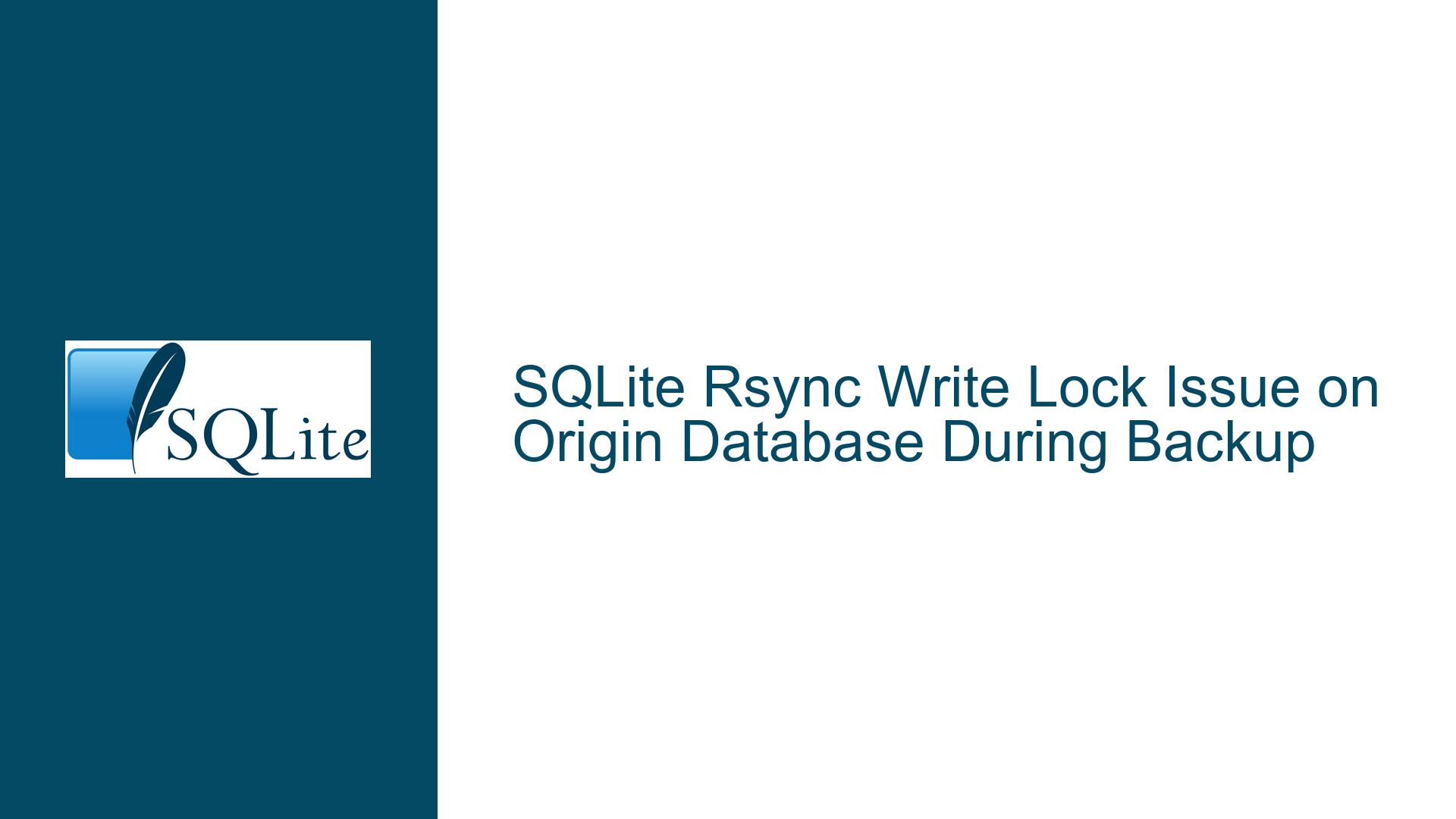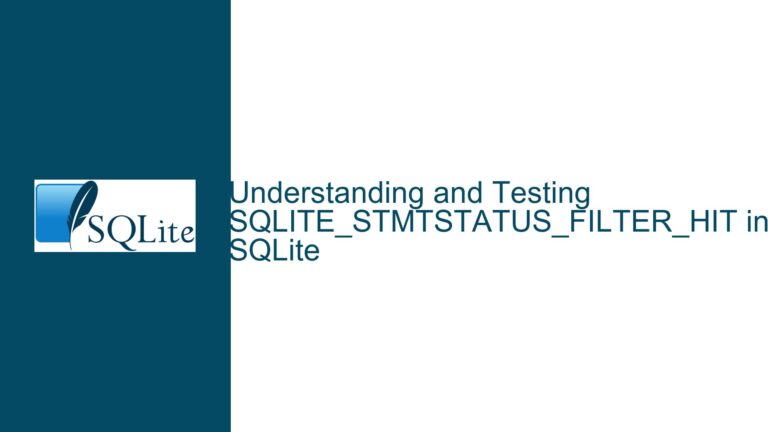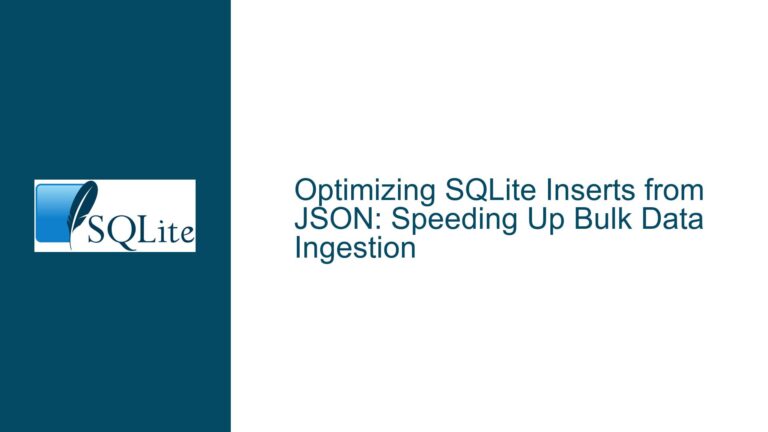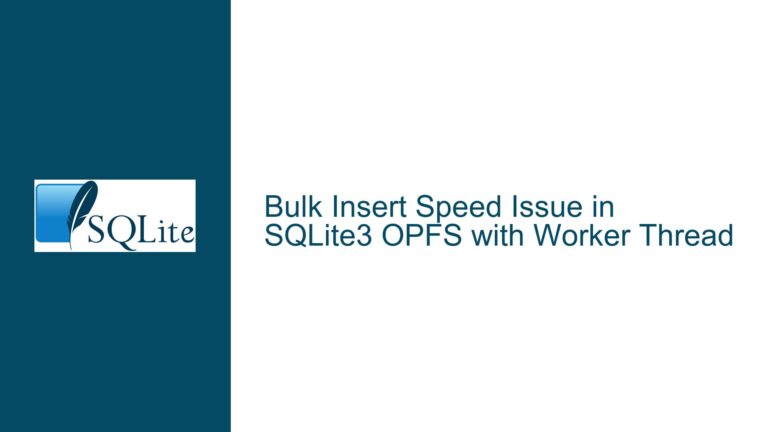SQLite Rsync Write Lock Issue on Origin Database During Backup
SQLite Rsync Utility Write Lock Behavior During Concurrent Database Access
The SQLite Rsync utility (sqlite3_rsync) is designed to facilitate efficient database synchronization by leveraging the rsync algorithm to transfer only the modified portions of a database. A key feature of this utility is its ability to allow concurrent write operations on the origin database while the synchronization process is ongoing. However, in certain scenarios, this concurrent access fails, resulting in SQLITE_BUSY errors or database lock issues. This post delves into the root causes of this behavior and provides detailed troubleshooting steps and solutions to resolve the issue.
Write Lock Contention During Rsync Hash Verification
The core issue arises from the interaction between the sqlite3_rsync utility and concurrent write operations on the origin database. Specifically, the utility performs a hash verification process to identify mismatched pages between the origin and replica databases. This process involves executing an SQL statement that writes to the temp database, which inadvertently triggers a write lock on all connected databases, including the origin database.
The problematic SQL statement is:
INSERT INTO badHash SELECT pgno FROM sqlite_dbpage('main') WHERE pgno=?1 AND hash(data)!=?2
This statement inserts mismatched page numbers into the badHash table in the temp database. However, the sqlite_dbpage virtual table is configured with the SQLITE_VTAB_USES_ALL_SCHEMAS flag, which causes the write transaction to escalate to a global write lock. As a result, any concurrent write operations on the origin database are blocked, leading to SQLITE_BUSY errors.
The SQLITE_VTAB_USES_ALL_SCHEMAS flag is intended to ensure consistency across all attached databases when using virtual tables. However, in this case, it inadvertently disrupts the concurrent access guarantees provided by the sqlite3_rsync utility.
Configuration and Transaction Management in Rsync Utility
The behavior described above is influenced by several factors, including the configuration of the sqlite3_rsync utility, the transaction management model used by SQLite, and the interaction between virtual tables and database schemas.
Virtual Table Configuration: The
sqlite_dbpagevirtual table is designed to provide access to the raw pages of a database. When configured with theSQLITE_VTAB_USES_ALL_SCHEMASflag, it ensures that any operations involving the virtual table are consistent across all attached databases. This configuration is necessary for certain use cases but can lead to unintended side effects, such as global write locks.Transaction Escalation: SQLite uses a locking mechanism to manage concurrent access to databases. Write operations typically acquire a reserved lock on the database, which allows other processes to read but not write. However, when a write operation involves a virtual table with the
SQLITE_VTAB_USES_ALL_SCHEMASflag, the lock escalates to a global write lock, blocking all other write operations.Concurrency Model: The
sqlite3_rsyncutility is designed to operate in a non-blocking manner, allowing concurrent write operations on the origin database. However, the hash verification process disrupts this concurrency model by introducing a global write lock.Database Connection Management: The behavior also depends on how the
sqlite3_rsyncutility manages database connections. If the utility opens a connection to the origin database without enabling shared cache mode or other concurrency-enhancing features, it may exacerbate the locking issue.
Resolving Write Lock Contention and Ensuring Concurrent Access
To address the write lock contention issue and ensure that concurrent write operations can proceed without interruption, the following troubleshooting steps and solutions can be implemented:
Modify the Hash Verification Query: The root cause of the issue lies in the SQL statement used for hash verification. By modifying this statement to avoid writing to the
tempdatabase, the global write lock can be prevented. For example, the query can be rewritten to use a temporary in-memory table or a different mechanism for tracking mismatched pages.Disable the
SQLITE_VTAB_USES_ALL_SCHEMASFlag: If thesqlite_dbpagevirtual table does not require consistency across all schemas, theSQLITE_VTAB_USES_ALL_SCHEMASflag can be disabled. This change will prevent the virtual table from escalating write locks to a global level.Use a Separate Connection for Hash Verification: The
sqlite3_rsyncutility can be modified to use a separate database connection for the hash verification process. This connection should be configured to operate in a non-blocking manner, such as by enabling shared cache mode or using theWAL(Write-Ahead Logging) journal mode.Implement a Retry Mechanism for Concurrent Writes: Applications that perform concurrent write operations on the origin database can implement a retry mechanism to handle
SQLITE_BUSYerrors gracefully. This mechanism should include a backoff strategy to avoid excessive retries and ensure that the application remains responsive.Optimize Transaction Management: The
sqlite3_rsyncutility can be optimized to minimize the duration of write transactions. For example, the utility can batch hash verification operations into smaller transactions, reducing the likelihood of lock contention.Upgrade to the Latest Version of SQLite: The issue described in this post has been acknowledged and addressed in recent versions of SQLite. Upgrading to the latest version of SQLite and the
sqlite3_rsyncutility can resolve the issue without requiring additional modifications.Monitor and Analyze Locking Behavior: Tools such as the SQLite command-line shell or third-party monitoring utilities can be used to analyze the locking behavior of the
sqlite3_rsyncutility and identify potential bottlenecks. This analysis can inform further optimizations and ensure that the utility operates as intended.
By implementing these solutions, the write lock contention issue can be resolved, allowing the sqlite3_rsync utility to operate efficiently while enabling concurrent write operations on the origin database. This ensures that the utility fulfills its promise of non-blocking database synchronization, making it a reliable tool for remote backups and replication scenarios.






